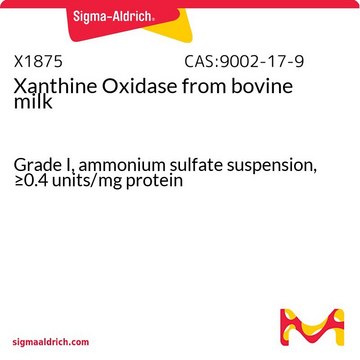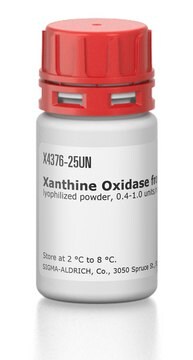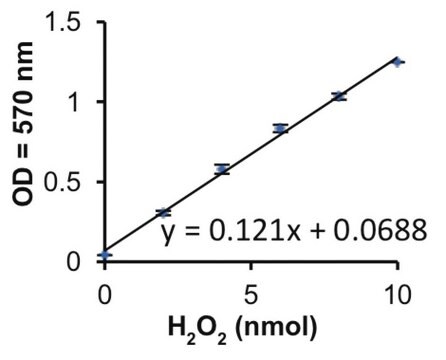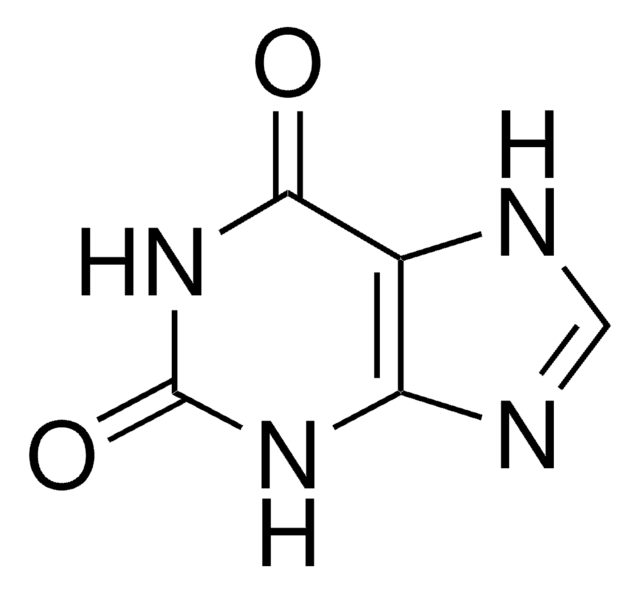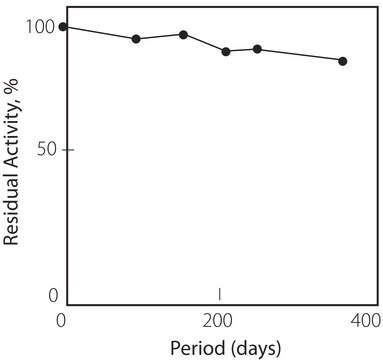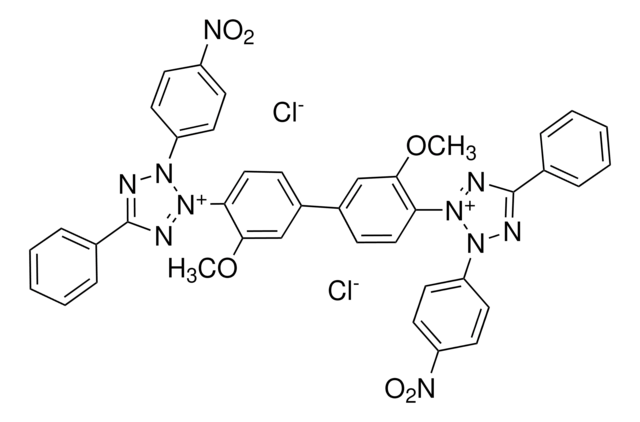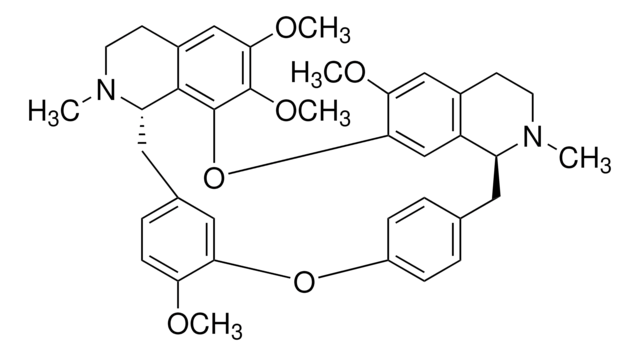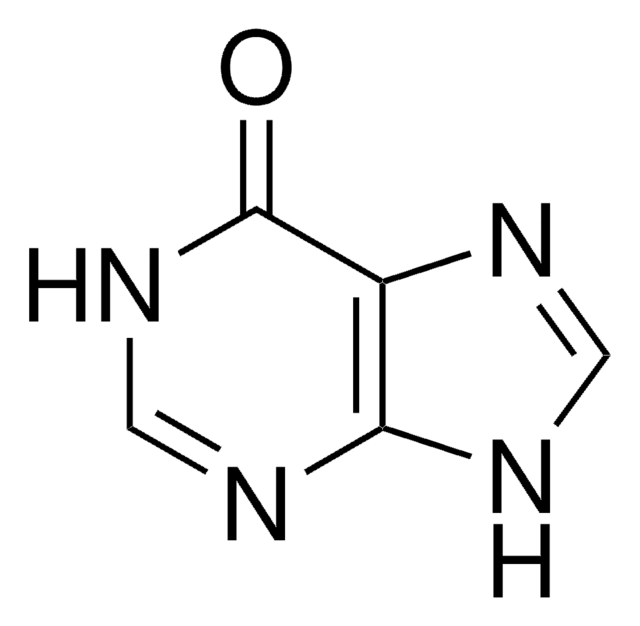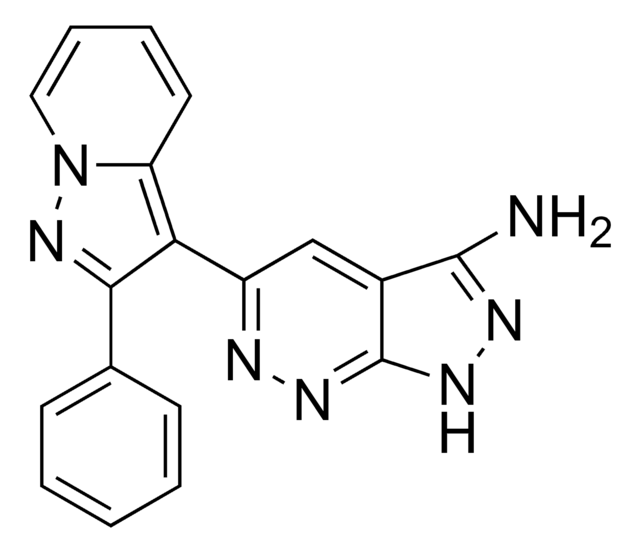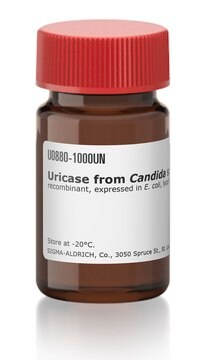X4875
Xanthine Oxidase from bovine milk
Grade IV, ammonium sulfate suspension, ≥0.1 units/mg protein
Synonym(s):
XOD, Xanthine:oxygen oxidoreductase
Sign Into View Organizational & Contract Pricing
All Photos(1)
About This Item
CAS Number:
Enzyme Commission number:
1.17.3.2.
EC Number:
MDL number:
UNSPSC Code:
12352204
NACRES:
NA.54
Recommended Products
biological source
bovine milk
Quality Level
type
Grade IV
form
ammonium sulfate suspension
specific activity
≥0.1 units/mg protein
storage temp.
2-8°C
Looking for similar products? Visit Product Comparison Guide
General description
Research area: Cell CycleXanthineoxidase (XO) is a homodimer. It is made up of two sub-units each made up of onemolybdenum and two iron-sulphur (2Fe-2S) centers.
Formerly E.C. 1.1.3.22
Application
Xanthine Oxidase from bovine milk has been used in superoxide dismutaseactivity assay.Xanthine oxidase may be suitable for producing amperometric biosensors and designing-flavonoid-type inhibitors against XO for treating inflammatory diseases, gout, and hyperuricemia. It may also be used in the synthesis of superoxide because of aldehyde oxidation.
Biochem/physiol Actions
Although xanthine oxidase is found widely distributed in multiple tissues, it is highly expressed in endothelial and epithelial cells. Its expression was also increased in infected tissues where it was shown to have an anti-microbial effect due to its ability to generate reactive oxygen species. Xanthineoxidase plays an important role in catalyzing the hydroxylation ofhypoxanthine to Xanthine. Later, xanthine is converted to uric acid isexcreted by the kidneys.
Xanthine oxidase is a molybdenum-containing enzyme that is found in the cytosol, and may be strongly inhibited by flavonoids. It plays a vital role in the metabolism of some drugs, as well as purines and pyrimidines. It is also known to be a biological source of reactive oxygen species.
Unit Definition
One unit will convert 1.0 μmole of xanthine to uric acid per min at pH 7.5 at 25 °C. Approx. 50% of the activity is obtained with hypoxanthine as substrate.
Physical form
Suspension in 2.3 M (NH4)2SO4 containing 1 mM sodium salicylate
Analysis Note
Protein determined by biuret
Signal Word
Danger
Hazard Statements
Precautionary Statements
Hazard Classifications
Resp. Sens. 1
Storage Class Code
10 - Combustible liquids
WGK
WGK 3
Flash Point(F)
Not applicable
Flash Point(C)
Not applicable
Personal Protective Equipment
dust mask type N95 (US), Eyeshields, Gloves
Choose from one of the most recent versions:
Already Own This Product?
Find documentation for the products that you have recently purchased in the Document Library.
Customers Also Viewed
Role of xanthine oxidoreductase as an antimicrobial agent.
Hannah M Martin et al.
Infection and immunity, 72(9), 4933-4939 (2004-08-24)
Xiaoqiang Chen et al.
Nature protocols, 11(7), 1219-1228 (2016-06-10)
During infection, nicotinamide adenine dinucleotide phosphate-oxidase of innate immune cells generates important microbicidal reactive oxygen species (ROS) such as hypochlorous acid (HOCl) to kill the invading pathogens. However, excess amounts of HOCl induce oxidative damage of functional biomolecules such as
M B Betancor et al.
Fish physiology and biochemistry, 41(3), 705-720 (2015-03-10)
In vertebrates, selenium (Se) is an essential micronutrient for vertebrates that is involved in antioxidant protection and thyroid hormone regulation among other roles and functions through its incorporation into proteins, the selenoproteins. Long-chain polyunsaturated fatty acids, such as docosahexaenoic acid
Elżbieta Studzińska-Sroka et al.
Antioxidants (Basel, Switzerland), 11(10) (2022-10-28)
Lichens are a source of various biologically active compounds. However, the knowledge about them is still scarce, and their use in medicine is limited. This study aimed to investigate the therapeutic potential of the lichen Platismatia glauca and its major
Alice B Nongonierma et al.
Food chemistry, 141(1), 644-653 (2013-06-19)
Xanthine oxidase (XO) and dipeptidyl peptidase IV (DPP-IV) inhibition by amino acids and dipeptides was studied. Trp and Trp-containing dipeptides (Arg-Trp, Trp-Val, Val-Trp, Lys-Trp and Ile-Trp) inhibited XO. Three amino acids (Met, Leu and Trp) and eight dipeptides (Phe-Leu, Trp-Val
Articles
Instructions for working with enzymes supplied as ammonium sulfate suspensions
Our team of scientists has experience in all areas of research including Life Science, Material Science, Chemical Synthesis, Chromatography, Analytical and many others.
Contact Technical Service